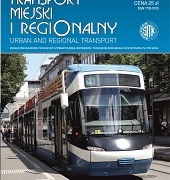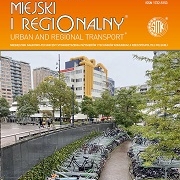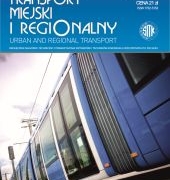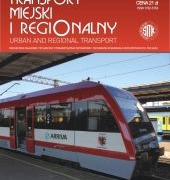Abstract 8/2012
Olgierd Wyszomirski
Twenty years of functioning of Urban Public Transport Authority (ZKM) in Gdynia
Urban Public Transport Authority in Gdynia (ZKM) is an administrative unit of Gdynia’s municipality which organizes services of public transport in Gdynia and six neighboring municipalities. Three stages can be distinguished during the period of twenty years of its functioning. At the first stage the competition in operation was introduced. Besides the municipal operator other state and private operators were introduced to the transport service. Transportation offer was designed on the basis of complex marketing research of consumer demand, preferences and transport behavior of the inhabitants. The quality of transport service has been significantly raised. At the second stage the economic efficiency of transport service was increased. Buses and trolleybuses were separated with regard to economic and legal conditionings, the participation of private operators was augmented and the municipal bus operators were made to tender for a contract. The highest ratio of expenses incomes from services during the history of the Urban Public Transport Authority in Gdynia was accomplished with 73 %. The third stage characterizes with the realization of innovative projects, most of all in trolleybus transport. The endowing of the vehicles, the distribution of tickets and the promotion of services were also covered with innovations. The water tram to the Hel Peninsula has been launched. At this stage, because of the economic, legal, political and social conditions the participation of the municipal operators in tenders has been cancelled as they were contracted with public transport services. The twentieth anniversary of the Urban Public Transport Authority in Gdynia constitutes a premise to conduct a SWOT analysis of the entity in order to identify its successes and failures and to determine the future plans refrerring to the expansion of the electronic ticket system, the introduction of electronic control of the vehicle motion as well as the integration of the public transport in the area of the entire Gdańsk Bay.
Keywords: urban public transport, urban public transport authority, organization and management
Zofia Bryniarska
Exploitation of bus-lanes in Krakow
Transport needs of population living in cities and large urban areas are getting more and more essential. The development of individual motorization and the increase of passenger and good transport traffic resulted with growing crowd and congestion on roads and streets. There are also other negative effects of road transport like climate changes, release of dangerous particles that affect human health and environment and much lower level of safety.
There are many organizational solutions to improve public transport performance and provide high quality services. One of them are separated bus-lanes dedicated only for means of public transport, taxis and emergency cars. Those lanes allow speeding up buses and reducing the passengers’ time spent inside them.
The results of survey run on the thoroughfare between the 29 Listopada Avenue and the Konopnicka Street have been given in the article. The survey rely on counting vehicles of urban, regional, long-distance and tourist public transport services, taxis, emergency cars and others that are not allowed to move on the separated bus-lane. The cars driving on regular lanes have also been counted. The results contain of the vehicles’ structure on the separated bus-lane, the number of vehicles not allowed to move on the separated bus-lane and the participation of vehicles on the separated bus-lane compared with the total number of cars driving that direction. There is also included the comparison of number of passengers traveling by buses on the bus-lane and in cars on the regular lanes of that street.
Keywords: passenger transport, collective public transport, separated bus-lanes
Zofia Bryniarska
Exploitation of bus-lanes in Krakow
Transport needs of population living in cities and large urban areas are getting more and more essential. The development of individual motorization and the increase of passenger and good transport traffic resulted with growing crowd and congestion on roads and streets. There are also other negative effects of road transport like climate changes, release of dangerous particles that affect human health and environment and much lower level of safety.
There are many organizational solutions to improve public transport performance and provide high quality services. One of them are separated bus-lanes dedicated only for means of public transport, taxis and emergency cars. Those lanes allow speeding up buses and reducing the passengers’ time spent inside them.
The results of survey run on the thoroughfare between the 29 Listopada Avenue and the Konopnicka Street have been given in the article. The survey rely on counting vehicles of urban, regional, long-distance and tourist public transport services, taxis, emergency cars and others that are not allowed to move on the separated bus-lane. The cars driving on regular lanes have also been counted. The results contain of the vehicles’ structure on the separated bus-lane, the number of vehicles not allowed to move on the separated bus-lane and the participation of vehicles on the separated bus-lane compared with the total number of cars driving that direction. There is also included the comparison of number of passengers traveling by buses on the bus-lane and in cars on the regular lanes of that street.
Keywords: passenger transport, collective public transport, separated bus-lanes
Urszula Kwaśniak, Michał Janicki, Czesław Kolanek
CO and NOx emission from vehicles’ engines, in the light of the euro norms
The dynamic expansion of road transport is clearly noticeable by natural environment and by human being (with its positive and negative aspects). Pollution emission with its negative impact on the environment results from fuel combustion in motor engine. Taking into consideration the sustainable statement in scope of road transport, it is necessary to prepare the Environmental Impact Assessment (considering state of environmental background) during the stages of planning and taking decison. This thesis describes CO and NOx emission from road vehicle estimated by current valid emission indicators and noting down traffic quantitative-qualitative composition for the selected section of roads in Wrocław. Results of calculation were presented in terms of class of vehicles and compared to each other.
The least difference in emission, considering different groups of vehicles, is observable for passenger cars and small buses (passenger vans). The biggest discrepancy – in regard to results achieved by aforementioned emission estimation – was noticed for lorries (trucks, heavy duty vehicles). It is important to pay attention to the fact that emission indicators show averaged results for all groups of vehicles moving around a country. At the same time European emission standards are based on more strict estimation methods that take into account number of cars from a specific group moving within an analyzed section of the road and their highest allowed emission level (approved limits of their emission).
Keywords: pollution emission, IC engine, emission factor, European emission standard .
Krystian Pietrzak
Analysis of possibilities to launch the Metropolitan Railway of Szczecin
In the paper conditions and possibilities of launch the Metropolitan Railway of Szczecin as a factor of the proper development of the future metropolitan area of Szczecin have been presented. The basic aim of the article is to point out the Szczecin railway network as a platform of implementing modern solutions of the metropolitan and urban railway concept. The issue seems to be very attractive due to the dynamic changes taking place in the agglomerations and metropolitan areas and the escalating effect of transport congestion. Rail transport in Poland has been still almost exclusively identified with the long-distance or regional services. Currently, rail transport has been used to operating within the settlement system only by a few Polish cities. Quantitative status of the railway infrastructure in Szczecin creates the opportunities of using this mode of transport to the traffic within the city, ensuring quick connection between all the districts of the city. In the article the author presents the solution of creating a quasi urban railway on the basis of slightly modified services of the Przewozy Regionalne Co. offering in the West Pomeranian region. The article is a result of the author’s participation in the research by Czesława Christowa in the Maritime University of Szczecin, under a development project on “Research on and modeling of mode-integrated transport system in the West Pomeranian region with a focus on the Central European Transport Corridor North – South CETC Route 65” financed by the National Research and Development Centre.
Keywords: metropolis, Szczecin Metropolitan Railway, urban railway, public urban transport, passenger transport
Waldemar Parkitny
Evaluation of selected qualitative factors of different types of services in railway passenger transport
Increasing competition in passenger railway carriages, including different types of transport, contributes with growing importance of the qualitative factors of realized services in the fight for customers. Selected results of surveys relating quality in railway passenger transports were presented in the article. The opinion of respondents – passengers of selected routes – travelling by trains of: the PKP Intercity S.A. – type Intercity Express (EIC) and Twoje Linie Kolejowe (TLK), as well as trains of the Przewozy Regionalne sp. z o.o. type interREGIO (IR) have been analysed. Surveys have been conducted on the following sections: Kraków Główny – Warszawa Centralna, Kraków Główny – Częstochowa and Tarnów – Nowy Sącz. Following qualitative factors: comfort / conditions of the journey, punctuality, time of the travel, frequency of courses, price for the ticket, quality of seats, cleanness of passenger compartments, level of noise, temperature in the train, personal safety in train, personal culture of the staff.
Keywords: quality, railway carriages, railway transport, passenger transport
Marta Zdanowicz-Dejnak
Drivers’ behaviour on bus lanes
Identification and analysis of dangerous behaviour on bus lanes were the main purpose of the research, results of which were analyzed and described in the article. The problem is very important since the number of bus lanes in Poland is growing and their effectiveness will be higher if car drivers do not use them illegally. Observation was carried out on the Juliusz Słowacki Avenue, on the road section between Pawia Street and Kamienna Street, where twelve bus lines are operating. Driving on the bus lanes should be fast and exclusively reserved for public transport but unfortunately it is not respected. The traffic intensity was measured on the separate lanes of indicated section. During the measuring following data were taken under consideration: types and number of vehicles, number and variety of incidents related to drivers’ behaviours as well as traffic safety on the chosen section. The analysis shows that the bus lane transmitted 18% of the traffic of the whole analysed section during the morning rush hour and 20% during the afternoon rush hour. However, more important is to observe that 60% of all vehicles on the bus lane in the morning rush hour and 50% in the afternoon rush hour are unauthorized vehicles (motor cars). It was observed that unauthorized vehicles were driving along the entire bus line or were entering into the bus line crossing the solid line. Passenger cars are a sizable group of vehicles that drive along a bus lane through a crossroad what is prohibited as well. Behaviour of motor car drivers’ which is against the rules has influence on the public transport and very often causes dangerous situations on the road so that one should make every effort to eliminate wrong behaviour. Automatic control of bus lanes is the easiest way to prevent their unauthorised use. Awareness of being “watched” effectively reduces breaking the rules. Public transport will be faster and prompt, what certainly would increase its popularity, if the bus lanes are used only by authorized vehicles.
Keywords: bus lanes, public transport, improvements for buses


 SITK RP
SITK RP  SITK RP
SITK RP  SITK RP
SITK RP  SITK RP
SITK RP  SITK RP
SITK RP 
 SITK RP
SITK RP SITK RP
SITK RP